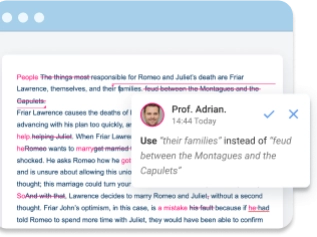How to Format Dialogue in an Essay: Tips on Writing
Table of contents
- 1 Purpose of Dialogue in Essays
- 2 Quotation Marks and Punctuation
- 3 New Speakers – New Paragraphs
- 4 Integrating Dialogue into an Essay
- 5 Examples and Exercises
- 5.1 Good Example 1: Use of Quotation Marks and Proper Punctuation
- 5.2 Bad Example 1: Incorrect Punctuation and Quotation Mark Use
- 5.3 Good Example 2: Integrating Dialogue Naturally into the Essay
- 5.4 Bad Example 2: Forced and Unrelated Dialogue
- 5.5 Good Example 3: Showing Character and Emotion through Dialogue
- 5.6 Bad Example 3: Overuse of Adverbs in Dialogue Tags
- 6 Craft Dynamic Dialogues: Let Your Reader Enjoy The Narrative of Your Essay
Adherence to basic guidelines is vital for creating successful interaction within an essay. This article outlines fundamental rules for effectively incorporating dialogue into an essay, ensuring it adds depth and authenticity. Today, we will talk about:
- How to write a dialogue in your essay;
- How to use quotation marks to create a format of dialogue writing;
- What are the subtleties of arranging paragraphs while beginning or continuing discourse;
- What are several approaches to assigning conversation to characters without being boring.
Now, let’s delve into the intricacies of each rule.
Purpose of Dialogue in Essays
Before we delve into how to write dialogue in an essay, we must first grasp why this literary element should be used. Dialogue is dynamic, elevating narratives by injecting life and authenticity into essays. Its role extends beyond mere conversation as a powerful tool to enhance clarity. Through dialogue, writers can open up the characters, making the narrative more interesting and relatable.
Additionally, it fosters a realistic touch, enabling readers to connect emotionally with the content. Indeed, the proper way to write dialogue is to unveil the nuances of characters’ personalities and relationships, which will foster a deeper understanding of the characters’ ideas, thoughts, and the essay’s context. Besides, it transforms it from static prose to dynamic.
Two Main Types of Dialogue
Dialogue writing in your text can differ based on the genre of the essay you work on. Whether crafting your persuasive, argumentative, or any other type of essay, you should know what types of dialogue you can use. There are two main options; knowing their differences is vital to using them effectively.
- Active Dialogue:
-
- This is when you place precise phrases inside quotation marks without altering the content. This is an excellent method to give readers a sharper and more direct understanding of a scenario:
Dan said, “I don’t want to go to dinner tonight.”
- Passive Dialogue:
-
- This is when you paraphrase someone else’s words to convey a general understanding of what they stated. When writing dialogue passively, add additional information or background to the paragraph:
Dan said he didn’t want to go to dinner as he was tired. Even though Joanna was disappointed to hear this, she agreed and suggested rescheduling it for next weekend.
Quotation Marks and Punctuation
Mastering the art of how to write dialogue in an essay necessitates following the correct punctuation conventions. Thus, a few simple but important rules are to be followed when adding voice to text. The good news is that you can always ask PapersOwl to help you with essay writing if you feel stuck. Rest assured, the academic writing process will be handled carefully, with separate speech tags and everything else needed.
However, students must grasp the intricacies of effectively writing dialogue between two characters within their essays to upgrade their work.
Essential Punctuation in Dialogue Writing
- The correct way to write dialogue is to enclose spoken words in double quotation marks and pay attention to the placement of commas and periods concerning the quotation marks:
- Correct: “I can’t believe you said that,” she exclaimed.
- Incorrect: “I can’t believe you said that”, she exclaimed.
- We use commas to write proper dialogue and to set off tags. These are also placed inside the quoting symbols:
- “I won’t have any more of this,” he said, “It has been too long since I’ve done anything of my own accord.”
- A period is placed after the closing quotation marks if the quote is located at the end of a sentence:
- Tiffany looked sadly at her brother and said, “I can’t believe we have ruined this cake so badly”.
Quoting Something Within the Dialogue
Use single quotation marks when quoting something within the dialogue for the proper dialogue format. This helps distinguish the inner quote from the main phrase.
For example:
- He said, “She told me, ‘I’ll be there by 3 PM.'”
New Speaker Indicator in Dialogue
When introducing a new speaker, the way to correctly write dialogue is to start on a new line and use a lowercase letter for the first word if it follows an action.
For example:
- She sighed. “I don’t know what to do.”
- He laughed. “You’ll figure it out.”
Showing Interruption in Dialogue
To indicate an interruption, use an em dash (—) and start a dialogue with a lowercase letter.
For example:
- “I was just trying to —.” And she cut him off. “I don’t want to hear it.”
Avoid using extra punctuation while using ellipses
While ellipses (…) can convey hesitation or trailing off, avoid adding extra punctuation around them. Let the ellipses carry the weight of the pause.
Dialogue example:
- Correct: “I’m not sure… maybe.”
- Incorrect: “I’m not sure…, maybe”.
Additional Tips on Writing Dialogue
There are also loads of other formatting rules that are better studied and remembered to uplift your dialogues in essays:
- When dealing with long speeches, break the dialogue into paragraphs for clarity. Begin each paragraph with an opening quotation mark, and only use a closing quotation mark at the end of the last paragraph:
- “In the grand tapestry of life, each thread weaves a story. Our experiences shape us, molding our characters into unique patterns. Challenges, like storms, may rattle us, but they also add texture to the narrative. And as we navigate this intricate design, remember:”
“Your journey is a masterpiece, with every twist and turn contributing to the beauty of your existence.”
- In a conversation beyond one paragraph, you should use opening quotations when it starts. However, the ending sign is used only when the conversation ends, even after several paragraphs.
- To sum up, while formatting dialogue, ensure that terminal punctuation (commas, periods, exclamation marks, or question marks) falls within the quotation marks, while colons and semicolons should be placed outside.
New Speakers – New Paragraphs
There are different ways to write dialogue, but starting a new paragraph for each speaker improves clarity in conversation presentation. This technique graphically indicates a shift in speakers, making it easier for readers to follow dialogues.
Integrating Dialogue into an Essay
Dialogue can effectively present information and provide depth to an article. Thus, using conversation between characters, writers may engage readers and create a dynamic story that supports their goal. Besides, there are different reasons to use dialogues in various contexts.
Contextualizing Dialogue
To correctly write a dialogue within the narrative is vital for creating a vivid and immersive storytelling experience. Accordingly, the setting serves as a crucial backdrop, influencing the conversation’s tone, mood, and dynamics. Meanwhile, descriptive details about the environment, such as the time of day, the weather, or the specific location, not only ground the reader but also add layers of meaning to the dialogue in an essay.
Additionally, dialogue gains authenticity and resonance by seamlessly integrating setting details, allowing readers to engage more fully with the characters and their world. For instance, the backdrop of a bustling city or serene countryside significantly influences how dialogue in paragraphs is interpreted, deepening the overall narrative experience. This contextual richness elevates spoken words into an integral part of the larger story, enhancing the entire reading experience.
Maintaining Flow and Relevance
To maintain a seamless flow and relevance in dialogue, you should:
- Align each spoken word with the essay’s central argument or narrative.
- Avoid extraneous conversations that do not contribute to the core message.
- Prioritize purposeful dialogue in writing that propels the storyline or reinforces the essay’s thesis.
- Ensure a natural flow by considering dialogues’ pacing, tone, and timing, allowing them to unfold organically within the broader narrative style and structure.
This strategic integration ensures that dialogue enhances the storyline and remains integral to the essay’s overarching purpose and coherence.
Balancing Dialogue and Narrative
Achieving a harmonious balance between dialogue and narrative involves strategic integration.
- Avoid extended monologues and instead effortlessly blend descriptive storytelling and exposition with dialogue.
- Insert dialogue in an essay to unfold character insights and advance the plot, while narrative provides context and depth.
- Create a rhythmic interplay between spoken words and descriptive elements, ensuring each complements the other.
This dynamic balance allows readers to interact with both characters and the surrounding universe, improving the narrative’s coherence and immersion.
Subtext in Dialogue
The subtext in dialogue sentences adds layers of meaning, allowing writers to convey underlying themes subtly.
- Utilize nuances, unsaid words, or indirect expressions to imply deeper emotions or unspoken tensions.
- Consider the characters’ motivations and the context of their conversation to infuse hidden meaning
Putting dialogue in an essay with subtext promotes engagement by encouraging readers to discern hidden subtleties and building a deeper connection with the story.
Character Development Through Dialogue
Character development thrives in the subtleties of dialogue, offering a window into personalities and relationships. Consequently, dialogue in text can effectively convey the thoughts and feelings of characters in a story. Moreover, it can create a stronger connection between readers and characters, helping them to understand their struggles, emotions, and motivations. We also advise the following:
- Employ distinctive speech patterns, vocabulary, and tones to convey individual traits authentically.
- Integrate narrative descriptions of characters’ movements and emotions during conversations to provide additional layers. For instance, a nervous character might fidget, while a confident one maintains steady eye contact.
- Write a dialogue in a story to unveil power dynamics, conflicts, or alliances, allowing readers to discern relationships organically.
By intertwining spoken words with nuanced actions and emotions, you breathe life into characters, fostering a deeper connection between readers and the personas within your narrative, resulting in a richer and more immersive storytelling experience.

Examples and Exercises
Writing dialogue in an essay can bring characters to life, illustrate points, and add interest to your writing. However, doing it well requires attention to detail, adherence to conventions, and purposeful integration into your essay’s narrative. Below, I will provide examples of both good and bad dialogue writing to highlight key points for effective dialogue inclusion in essays.
Good Example 1: Use of Quotation Marks and Proper Punctuation
Good:
- “I don’t understand why we have to move again,” Sarah said, her voice laced with frustration.
- “It’s because of my job,” her father explained. “We’ll get to explore a new place together.”
Why it’s good: This example correctly uses quotation marks to enclose the spoken words and includes proper punctuation, with the comma inside the quotation marks. The dialogue tags (“Sarah said,” “her father explained”) are used effectively to attribute the dialogue to specific characters.
Bad Example 1: Incorrect Punctuation and Quotation Mark Use
Bad:
- I don’t understand why we have to move again. Sarah said, her voice laced with frustration.
- It’s because of my job. her father explained We’ll get to explore a new place together.
Why it’s bad: This example fails to use quotation marks, making it difficult to distinguish between the narrative and the dialogue. The punctuation is incorrectly placed outside the quotation marks, and the dialogue tags are awkwardly integrated, leading to confusion.
Good Example 2: Integrating Dialogue Naturally into the Essay
Good:
In the midst of their argument, Sarah’s realization about her family’s situation was profound. “Maybe it’s not about the moving but about finding where we belong together,” she mused. This moment of insight not only resolved their conflict but also underscored the essay’s theme of belonging.
Why it’s good: This dialogue is naturally integrated into the essay, contributing to the development of the theme. It shows how to use dialogue to reveal character development and thematic elements, enhancing the reader’s understanding of the essay’s message.
Bad:
Sarah liked ice cream. “I love chocolate,” she said. Meanwhile, her father was talking about moving because of his job.
Why it’s bad: This example includes dialogue that is unrelated to the essay’s focus, disrupting the flow of the narrative. The dialogue about ice cream does not contribute to the development of the theme or the characters in the context of moving due to a job change, making it feel forced and out of place.
Good Example 3: Showing Character and Emotion through Dialogue
Good:
As they packed the last box, Sarah’s father sighed, “I know this is hard on you.” Sarah looked up, teary-eyed, “It’s okay, Dad. I understand it’s for the best.”
Why it’s good: This example effectively uses dialogue to convey emotion and character relationships. It shows rather than tells the reader about the characters’ feelings, creating a more immersive and emotional connection to the narrative.
Bad Example 3: Overuse of Adverbs in Dialogue Tags
Bad:
“I just can’t bear it anymore,” Sarah said sadly. “We will make it through this,” her father reassured her encouragingly.
Why it’s bad: The overuse of adverbs in dialogue tags (e.g., “said sadly,” “reassured her encouragingly”) can make the writing feel clumsy and over-explained. It’s often better to convey emotions through the dialogue itself or through descriptive action rather than relying on adverbs.
In summary, good dialogue writing in essays involves using proper punctuation, integrating dialogue naturally, and using it to reveal character and advance the theme. Avoid unrelated dialogue, incorrect punctuation, and over-reliance on adverbs in dialogue tags to maintain the quality and effectiveness of your essay’s narrative.
Craft Dynamic Dialogues: Let Your Reader Enjoy The Narrative of Your Essay
Several key conclusions emerge after discussing the conversation in writing. From mastering punctuation nuances to providing contextual richness through setting details, the art of creating dialogue extends beyond spoken words. Thus, to write dialogue in a narrative means finding a balance between dialogue and narrative, infusing subtext, and using conversations to shape characters are paramount.
Remember, writing dialogue is not merely a tool for communication; it is a dynamic way to enrich narratives. By acquiring these skills, you can tell fascinating stories in which every spoken word adds value to the larger picture of your essays. Just follow our guide, practice often, and you’ll never have to worry about this issue further!







